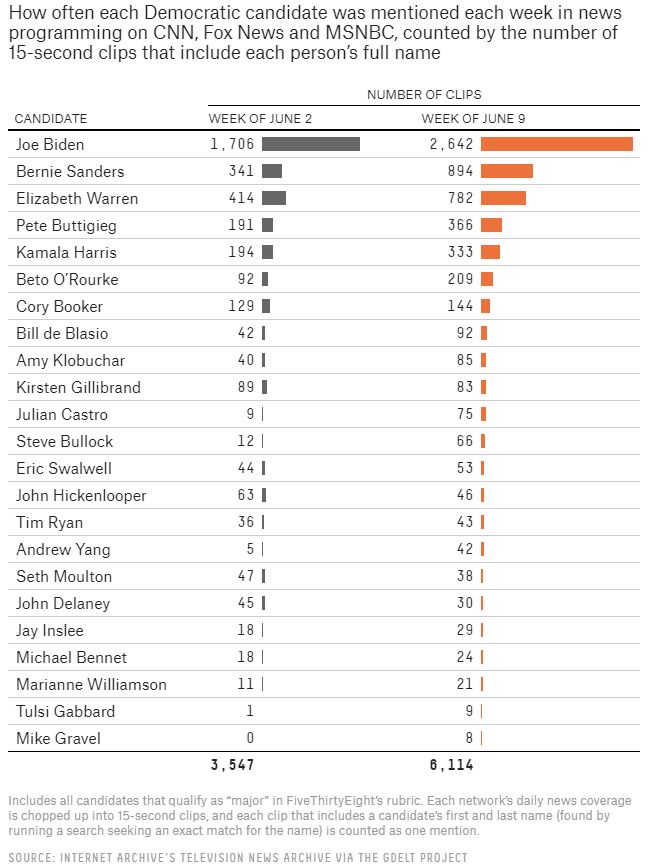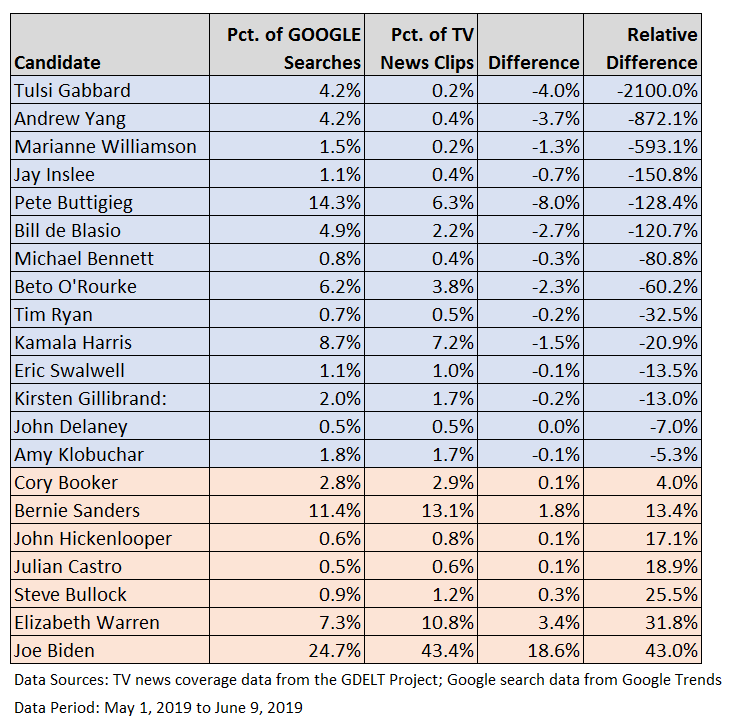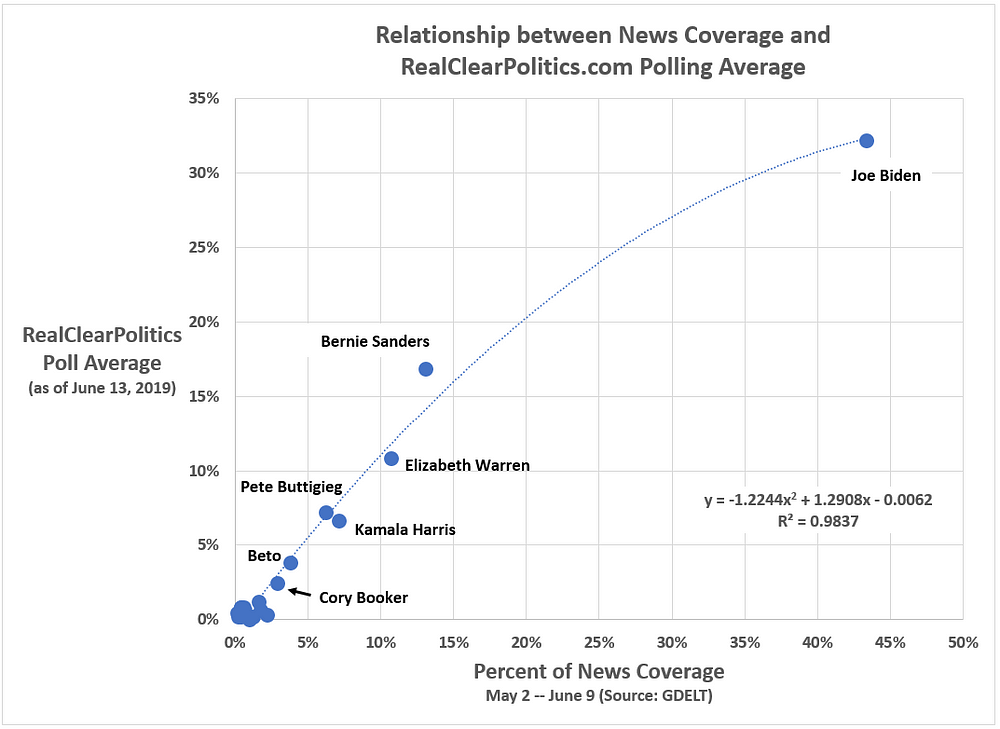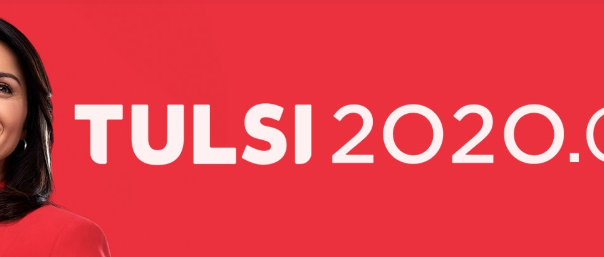By Kent R. Kroeger (Source: NuQum.com; June 24, 2019)
One of the thought eddies spiraling around Twitter lately has been a claim offered by supporters of Democratic presidential candidate Tulsi Gabbard, Tulsicrats as they are called, that the cable news networks are deliberately ignoring Gabbard’s campaign.

Jake Mercier wrote on Medium.com recently about the lack of television news coverage for the Gabbard presidential campaign (and Mike Gravel’s as well), despite her higher polling numbers relative to other more frequently covered campaigns (Kirsten Gillibrand and Cory Booker, for example).
One of the charts from his article was drawn from FiveThirtyEight.com’s recurrent analysis of GDELT Project data. According to the project’s website, it is supported by Google Jigsaw and “monitors the world’s broadcast, print, and web news from nearly every corner of every country in over 100 languages and identifies the people, locations, organizations, themes, sources, emotions, counts, quotes, images and events driving our global society every second of every day, creating a free open platform for computing on the entire world.” [If you love data, and lots of it, this is a project you will want to become acquainted with as soon as possible.]
For FiveThirtyEight.com’s analysis, GDELT’s data extract from Vanderbilt University’s TV News Archive is queried for how often the 2020 Democratic candidates are mentioned in cable news since December 30, 2018 across CNN, Fox News, and MSNBC.
Figure 1 shows the results for the first two weeks of June. The results are striking. Gabbard received just one mention in the week of June 2nd and just eight in the week of June 9th. Only Mike Gravel’s campaign was mentioned less. The most mentioned candidate was, of course, Joe Biden’s (1,706 and 2,642 mentions, respectively).
Figure 1: Television news coverage of the Democratic candidates (early June)

Source: FiveThirtyEight.com
If Gabbard were significantly less popular than Marianne Williamson or John Hickenlooper or Jay Inslee or John Delaney or Seth Moulton, her campaign would have little to complain about in the volume of its network coverage.
But she is even with or ahead of these candidates, according to the RealClearPolitics.com’s most recent rolling poll average (see Figure 2). For certain, Gabbard is in the lower tier of candidates with an RCP poll average at a mere 0.6 percent.
Yet, it is hard to explain how former Colorado John Hickenlooper, who doesn’t break above 0.4 percent in the RCP poll average, should be getting 10 times the cable news mentions as Gabbard. Unless, the news media really is deliberately ignoring Tulsi Gabbard.
Figure 2: RealClearPolitics.com’s Poll Average for the 2020 Democratic candidates (June 6 — June 18)

Still, Gabbard’s critics and news media apologists will rightfully point out that any candidate with polling that low is not likely to get significant coverage and the observed differences in mentions among the lower-tier candidates is probably noise. They have a seductive argument, but it is a tautological one.
Candidate support, as measured by the polls, is directly influenced by the amount news coverage the candidates receive, according to a study of the 2016 presidential race. And, while there is also a feedback loop where a candidate’s popular support influences how much media coverage they receive, the quantitative research tends to show the strongest direction of influence is from media coverage to candidate/party support.
Which is why Figure 3 (below) is interesting. Using Google Trend’s open data on Google searches and comparing that data to the relative volume of cable TV mentions, we find that the public’s interest in Gabbard (as measured by Google searches) far exceeds her mentions in the cable news media. Since the data in Figure 3 covers the period from May 1 to June 9, 2019, some of the variation is affected by the candidates that announced their candidacy in this period (e.g., New York Mayor Bill de Blasio).
However, for Gabbard, it is apparent that public interest in her campaign is greater than its news media coverage — a four percent gap, to be exact (4.2 percent versus 0.2 percent, respectively), which is among the highest across the Democratic candidates. In fact, only South Bend Mayor Pete Buttigieg may have a bigger complaint with the news media, where he received 14.3 percent of Google searches from May 1 to June 9, but only 6.3 percent of cable TV news mentions. [I realize, it feels like Buttigieg is mentioned every 10 seconds on MSNBC and CNN; but, in truth, he’s seen a significant drop in relative coverage since his initial burst on to the scene.]
Figure 3: Comparing Google searches on candidates with candidates’ mentions on cable TV news

And which candidates should not be complaining right now? Joe Biden (24.7% of Google searches versus 43.4 percent of cable TV news mentions), and to a lesser extent, Elizabeth Warren (7.3% of Google searches versus 10.8 percent of cable TV news mentions).
The cable TV news networks, at least from May to mid-June, were pushing Joe Biden more than any other candidate…by far. Bernie Sanders was second in cable TV news mentions at 13.1 percent. Admittedly, this cross-sectional data cannot prove causation. But it is consistent with more rigorous methodologies (pooled-individual and aggregate time-series studies) that demonstrate how media coverage moves poll numbers.
And why do we care? As pointed out, news coverage can change poll numbers and Figure 4 shows that relationship. And that relationship is strong, explaining 98 percent of the variance in the Figure 4 graph. Also notable is Bernie Sanders’ numbers. He polls higher than his news coverage would suggest he should (i.e., he is located above the polynomial regression line). This could be the result of his being a well-known quantity arising from the 2016 campaign. He may not need the coverage to the extent as a candidate like Gabbard.
Figure 4: Relationship between candidates’ RCP poll averages with their mentions on cable TV news

It may have diminishing returns as candidates become more popular, but the cable TV networks are unmistakably in a very powerful position to change the fortunes of any candidate they chose to cover.
Figure 5 shows the number of cable TV news mentions for the top-tier Democratic candidates and Tulsi Gabbard. The average candidates received 186 mentions from May 1 to June 9. Gabbard received 45. New Jersey Senator Cory Booker polls about 4 times higher than Gabbard but received 15 times the news coverage.
Figure 5: Cable news coverage (mentions) for a selection of Democratic presidential candidates

If we convert the percent of news coverage (the x-axis in Figure 4) to number of clips, for every 300 mentions over a six-week period, a candidate can expect a lift of about 1 percentage point in their polling average.
At 45 mentions over the six-week period (May 1 to June 9), Gabbard is not going to start rising in the polls any time soon. She simply does not receive the news coverage necessary to move her public support numbers.
Is that the cable news media’s fault?
Based on this cross-sectional data, the answer is an emphatic ‘yes.’
- K.R.K.
Send comments to: kroeger98@yahoo.com
